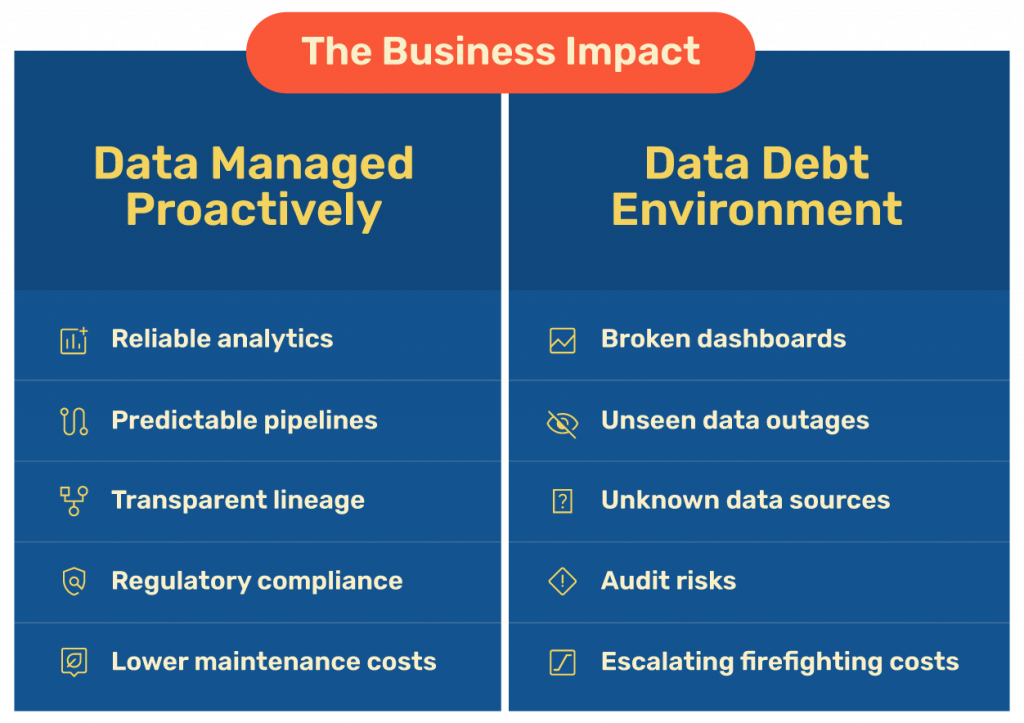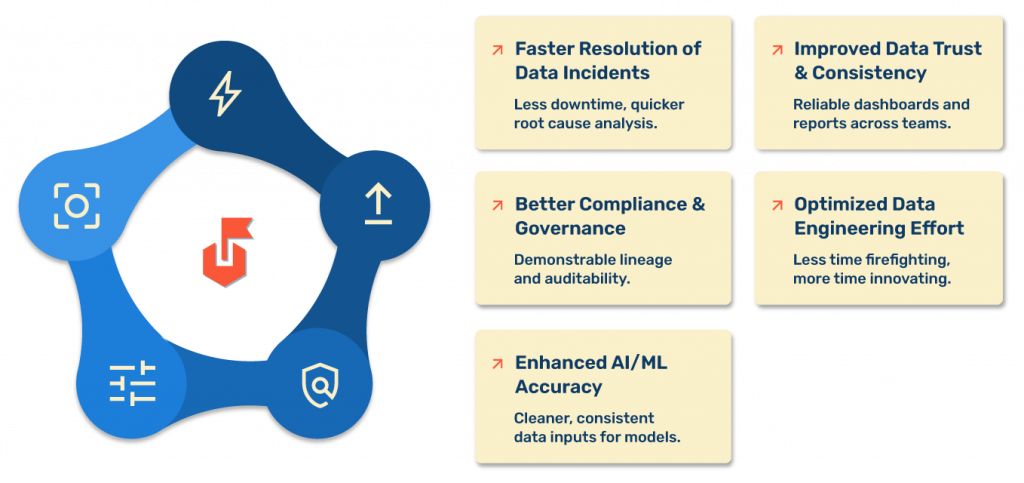Data debt is a quiet liability few organizations discuss, yet it costs enterprises millions yearly. Like technical debt, data debt stems from years of shortcuts, patchwork integrations, and neglected data management practices. If left unchecked, it undermines data-driven initiatives, erodes business trust, and amplifies compliance risks.
Gartner predicts that by 2025, data debt will obstruct 70% of digital transformation projects. Businesses race to modernize analytics, deploy AI, and unlock data value, so overlooking the foundations of data reliability can halt progress faster than most expect.
What Drives Data Debt?
The four major items that drive data debt are.
#1 Lack of Documentation
Poorly documented data pipelines and schemas obscure lineage and ownership.
#2 Siloed Data Ecosystems
Disconnected systems and teams create fragmented visibility.
#3 Unmonitored Data Pipelines
Without monitoring, silent failures, schema changes, and data lags slip through undetected.
#4 Reactive Fixes
Short-term patches to data issues bypass long-term solutions, creating compounding fragility.
The Business Impact Of Data Debt

The organizations plagued by data debt face the following:
- Delayed, inaccurate decision-making
- Increased operational risk and regulatory exposure
- Rising costs from constant rework and troubleshooting
- Erosion of confidence in analytics and AI outputs
An authorized source estimates up to 30% revenue loss annually due to poor data quality and management inefficiencies.
Why 2025 Demands Strong Data Observability
Today, enterprise data stacks span multi-cloud platforms, third-party SaaS apps, and hybrid on-prem systems. As pipelines scale in complexity, continuous visibility is mission-critical.
Modern challenges amplify the need:
1. Rising regulatory demands
Data privacy laws and AI regulations mandate auditable, traceable data.
2. AI/ML dependence
Models are only as good as the data fueling them; bad data means bad predictions.
3. Increased stakeholder scrutiny
Boards expect reliable, explainable analytics to back business decisions.
What Top Data Observability Platforms Offer
The best observability platforms today deliver far more than simple monitoring. They provide deep, continuous insights into data behavior, quality, and lineage across the enterprise.
Key Capabilities:
– Pipeline Health Monitoring
Track availability, detect bottlenecks, and flag failed jobs instantly.
– Anomaly & Drift Detection
Identify unusual patterns, sudden spikes/drops, and schema drifts automatically.
– Data Quality Metrics
Monitor completeness, uniqueness, null rates, and data distribution shifts.
– Lineage Tracking
Visualize data flow from source to consumption to understand dependencies and impact.
– Automated Alerts & Insights
- Proactive notifications before issues affect downstream consumers.
Top platforms like Qualdo-DRX exemplify this shift, offering unified observability capabilities that help enterprises track data reliability, catch anomalies early, and maintain trust in every pipeline at scale.
Strategic Benefits for Enterprises

- Faster Resolution of Data Incidents – Less downtime, quicker root cause analysis.
- Improved Data Trust & Consistency – Reliable dashboards and reports across teams.
- Better Compliance & Governance – Demonstrable lineage and auditability.
- Optimized Data Engineering Effort – Less time for firefighting means more time for innovating.
- Enhanced AI/ML Accuracy – Cleaner, consistent data inputs for models.
Forrester research shows organizations leveraging observability platforms reduce data downtime by 35% and cut incident resolution time by 40% on average.
A Practical Path to Reducing Data Debt
Get five healthy ways that help enterprises reduce data debt.
1. Audit and Map Your Data Landscape
Document pipelines, integrations, and ownership. Identify fragile systems and undocumented processes.
2. Embed Observability Across the Stack
Ensure monitoring covers ingestion, transformation, storage, and consumption layers.
3. Establish Data Ownership & SLAs
Assign accountable data owners and define service-level agreements for reliability and timeliness.
4. Adopt a Comprehensive Observability Platform
Choose tools that consolidate anomaly detection, lineage tracking, quality monitoring, and alerting into a single pane.
5. Operationalize Data Quality Scorecards
Use scorecards tied to business KPIs to track improvements and communicate progress to leadership.
Build Data Confidence for the Future
Data debt is more than an abstract IT issue. It’s a tangible business risk that limits growth, innovation, and compliance. Organizations that proactively invest in modern observability platforms position themselves to:
- Restore and maintain data trust
- Scale analytics and AI initiatives confidently
- Meet evolving regulatory demands with ease
- Reduce long-term operational costs
In 2025, enterprises that see data observability as strategic infrastructure, not just a technical add-on, will lead in digital resilience and innovation.



